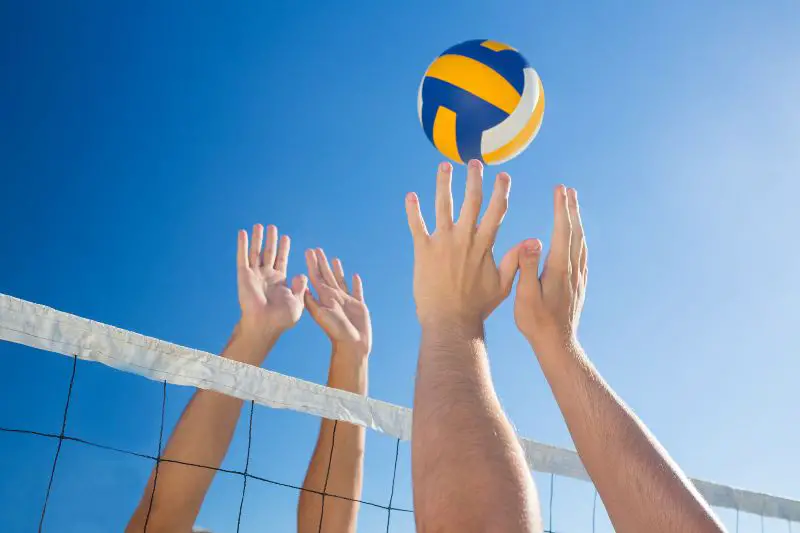
When it comes to the rules, beach volleyball is a very simple game. However, there are couple aspects of the game that could be confusing or not clear, at least for beginners …
One of those aspects is related to setting. Indeed, many beginners are not sure whether they are allowed to set the ball directly over the Net and whether they can do it from the first touch.
In this article I breakdown these concerns in very simple words. I also explain what actually makes an illegal set so you can avoid that.
Can you set the ball over the net in beach volleyball?
There are many controversies and debates surrounding the setting over the net in beach volleyball. That is mainly because the sets are always open for interpretation, from the players and from the referees.
The answer is yes, you can set the ball over the net in beach volleyball. The positioning of your body and your intentions are the key factors here, and they are all susceptible to interpretation, form the opponents to the referee.
There are debates on that whether you can set on the first, second or third contact. The short answer is that everything is allowed, but it is judged from the referee’s point of view.
- If a player intentionally sets the ball on the second contact over the net (the intention must be clearly visible by his body alignment) and scores a point, than it is legal and there is nothing that you can do about it.
- If a player sets the ball intentionally over the net and his body is not properly aligned with the ball direction that would be regarded as a fault.
Let’s say his body was facing his teammate when he was setting the ball over the net, and that it is obvious that his intentions were to set the ball over the net, that would be considered as a fault.
If he unintentionally sets the ball over the net while performing a set to his teammate (regardless of body alignment), then that would not be considered a fault, but it must be obvious that he made a mistake while setting.
Important Tip: If you are an amateur and not used to hot sand while practicing, the you definitely need to use sand socks. They will also give you a more stability and strength when jumping which would results in better performance overall. For example, these quality sand socks are reliable and will help in that regard.
Can you set over the net on the first touch in beach volleyball?
Yes, you can set the ball over the net on the first touch, but there are some conditions that need to be met …
Keep in mind that in beach volleyball players usually have a hard time receiving the ball, since it travels, when properly served over 80mph or 120kmh leaving little to no space to set the ball on the first contact!
That is however not forbidden because it is completely legal when it is in the boundaries of the rules.
If you carry the ball or double it then it will be a fault. Even the double and carry faults are susceptible to interpretation, because a set can be misinterpreted as a carry, and a double is allowed in some specific situations.
So in conclusion you can set the ball on first contact, although it is hardly possible to do so because of the speed of the ball, but it is theoretically possible …
You can set the ball on the second contact also, the third is the charm, so there is no problem with it.
What are the overall rules for setting in beach volleyball?
So far we have seen some of the rules regarding setting in beach volleyball. Here we will basically go a little deeper to have a better understanding …
Rules allow players to set the ball on the first, second and third contact, but with specific requirements such as the body position of the player, the positioning of his hands etc …
A player can let the ball slide in his hands, with bent elbows and then perform a set. This can sometimes be misinterpret as a carry because of the fast pace of the game, but if the ball has not touched the hands of the player while sliding into a perfect setting position it is a legal move.
A double is when the ball leaves one hand before the other while a player is setting the ball. However, there is one legal move that is similar to the double.
The move depends on the pace of the game and on the “hopelessness” of the situation. If there are slim to no chances of saving a ball, a double will be regarded as a try, not a successful move.
So basically an obvious double is not allowed, but a potential save is allowed, no matter the looks of it.
Illegal moves are those that we have compared to the legal moves. A double and a carry are the most common illegal moves when it comes to setting. A double represents a move where the ball exits one hand before the other. That move is illegal because it can mess with the trajectory and the direction of the ball.
A carry is when the player intentionally lets the ball slide into his hands, while having constant contact with the ball, and then “setting” the ball, that is carrying it into the air.
What is an illegal set in beach volleyball?
Illegal setting in beach volleyball is comprised out of a few moves that are always open to interpretation. The interpretation is open to debate but it always depends on the judgment of the referee.
- If a player sets the ball intentionally over the net and his body is not properly aligned with the ball direction, then that would be regarded as a fault.
- If his body was facing his teammate in the time when he was setting the ball over the net, and that it is obvious that his intentions were to set the ball over the net that would be a fault.
- If he unintentionally sets the ball over the net while performing a set to his teammate (regardless of body alignment), then that would not be considered a fault, but it must be obvious that he made a mistake while setting.
Of course there are the illegal moves that we have already mentioned, the carry and the double. We will explain them here again nonetheless.
So a carry is when the player positions his hands in a way that he is ready to perform a serve but instead of serving he lets the ball slide into his hands and then he basically carries the ball into the air, instead of “hitting” it.
The second move is a double. A double represents a move that involves the ball and the player’s hands. A double is when the ball leaves one hand before the other. So basically the ball leaves the right hand before the left hand. This is a double.
Can a Setter touch the Net?
When it comes to beach volleyball and indoor volleyball regarding the contact with the net the rules are very clear…
Contact with the net is strictly forbidden, there are of course some cases where that is allowed, but they are, again, susceptible to the referees judgment.
A player can touch the net, that is, he can have contact with it in case he touched it with no intention of doing so, meaning that it is allowed in those cases when the player is in the middle of the game and when he has no control over it.
However, if he does it intentionally that is rearded as a fault and will be sanctioned accordingly to the rules.
It is strictly forbidden for a player, not just the setter to have contact with the net in beach volleyball.
Are those rules different from indoor volleyball?
Everything that we have listed so far when it comes to the rules regarding the setting of the ball over the net in beach volleyball is relevant for indoor volleyball as well.
The first, second and third contact, the carry, the double, and the body to ball trajectory set are all viable in indoor volleyball.
If a setter sets the ball over the net on first contact it is legal. If the setter sets the ball over the net on second contact it is legal. If the setter sets the ball on third contact it is also viable.
However, the double and the carry are forbidden and are as well susceptible to the interpretation of the referee. This stands also for the “accidental” setting of the ball that depends upon body alignment.
There you have it, beach volleyball and indoor volleyball have the same rules when it comes to setting the ball over the net.
Final Thoughts …
To be honest, I am not a big fan of explaining these kinds of rules that might be confusing. Yet, I am glad that I’ve done so in this article, because I know for a fact that many beginners are not actually aware of these rules or are having a hard time getting them right in their minds …
This, not only will help them learn those rules clearly, but also it will help refine their style of playing to not violate those rules.
Finally, I invite you to learn whether you should touch the net in beach volleyball … You will find that very interesting.
